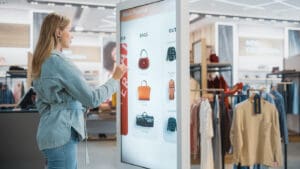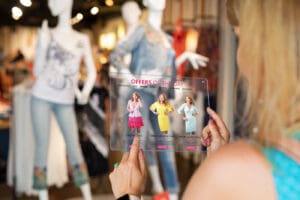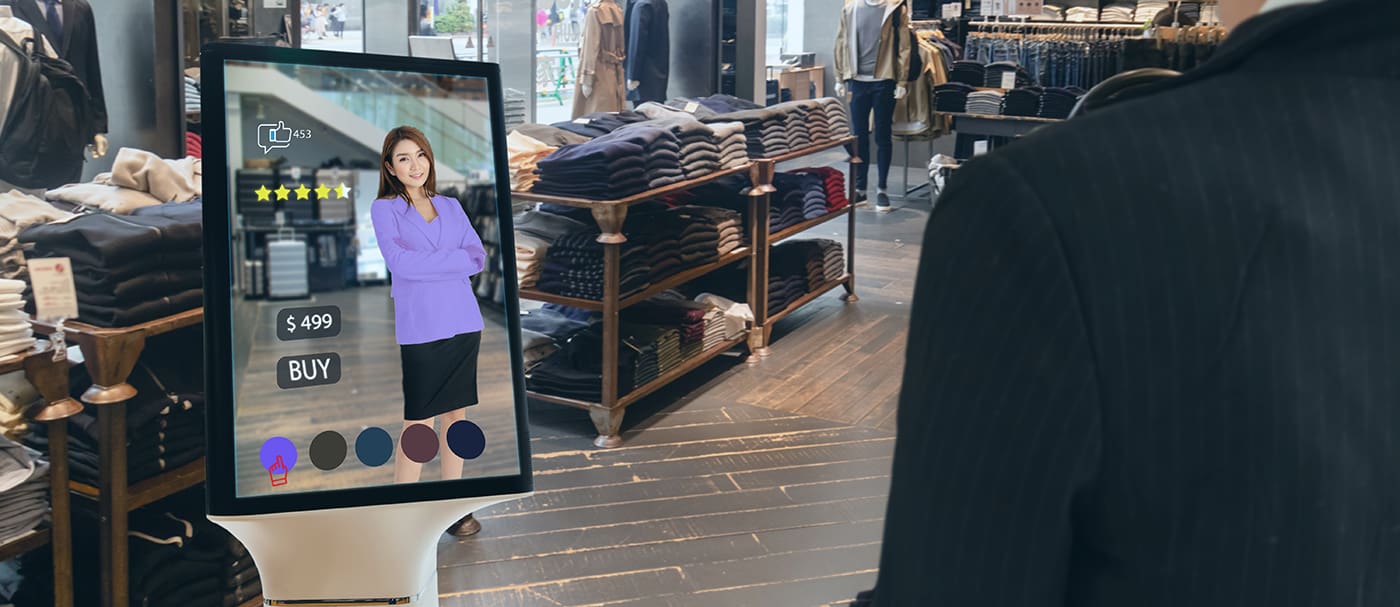The retail industry has experienced more disruption in the last five years than in the thirty years prior.
Cliched, but true.

The recent NRF 2024 Retails Big Show proved more changes are afoot in the ever-evolving retail landscape. The show’s conclusion left a palpable buzz, with AI, personalization, and metaverse shopping generating excitement.
We were on the floor at the Javits Center in New York City to follow these and other important topics and the retail leaders discussing them.
Looking Ahead: Retail Technology Trends for 2024
Consumers are now prioritizing speed and sustainability over traditional shopping habits. The evolution of retail ecosystems has blurred the lines between suppliers and customers. Employees increasingly seek flexibility in the workplace instead of the traditional rigidity of retail jobs. Amid this upheaval, shareholders demand profitable growth, creating a challenging landscape for retail leaders.
From advanced algorithms and artificial intelligence (AI) to immersive technologies and sustainability initiatives, retailers are navigating a dynamic market. This is a critical moment for retailers to adapt and thrive in the evolving landscape.
“A simple request for a better commerce solution or personalized marketing can quickly lead to a deep dive into back-office discussions. Creating a seamless and effortless retail experience involves navigating the iceberg of capabilities beneath the surface—real-time inventory management, swift and accurate pick, pack, and ship processes, and efficient return capabilities. It’s the hidden foundation that ensures retailers can meet the rising expectations of today’s consumers. “- Kristin Howell, Global Vice President, Retail Solution Management at SAP. – What Retailers Need to Know About Future-Proofing Business
The choices retailers make in the next few years could decide how well they do for the next 20 years. So, we’ve compiled a list of trends that are steering the future of retail, each bringing opportunities and challenges for retail executives to focus on in the coming year.
Algorithmic Retail – AI, ML, Smart Store, Automation, Immersive Tech
 The advent of generative AI (gen AI) marks a transformative era. Thousands of companies globally are already using gen AI to revolutionize business activities. The challenge is to discern its applicability, scale its adoption, and understand its industry-wide impact.
The advent of generative AI (gen AI) marks a transformative era. Thousands of companies globally are already using gen AI to revolutionize business activities. The challenge is to discern its applicability, scale its adoption, and understand its industry-wide impact.
While many have initiated the transformation, few have undertaken the organizational rewiring across talent, operating model, technology, and data capabilities to achieve long-term success.
AI and Machine Learning Revolutionizing Operations
Artificial Intelligence and Machine Learning are game changers in the retail sphere. These technologies are optimizing inventory management and revolutionizing demand forecasting. Retailers can now accurately predict consumer preferences and streamline supply chains.
Smart Stores for Enhanced Customer Experience
Integrating smart technologies within physical stores creates an interactive and personalized shopping experience. IoT devices that track customer movements, beacons that send targeted promotions, mobile payment options, scan-and-go systems, and smart shelves are reshaping the traditional brick-and-mortar experience.
Automation Streamlining Operations
Automation isn’t just robots handling routine tasks. It’s also enhancing efficiency across the board. Stores employ Robotic Process Automation (RPA) for inventory tracking, order fulfillment, and customer service. This allows their human resource staff to focus on more strategic aspects of retail.
Immersive Technologies Redefining Engagement
Immersive technologies such as Augmented Reality (AR) and Virtual Reality (VR) are breaking barriers between the physical and digital realms. Customers can now virtually try on products or experience a product in a simulated environment, adding a new dimension to the retail experience.
Diversification of the Customer Experience (CX)
The traditional in-store browsing and product discovery experience has become fragmented. Many consumers, particularly millennials and Gen Zers, now rely on social media and influencers for purchase inspiration. Shopping habits have become more fluid. Shopping for groceries is even transitioning into an omnichannel experience.
Resurgence of the Store Experience

Contrary to the predictions of the demise of physical retail, there is a resurgence in the importance of the store experience. Retailers recognize the value of creating unique in-store experiences beyond transactions.
Assortment and Fulfillment Strategies
Diversification extends to product assortments and fulfillment strategies. Retailers are offering a wide array of products to cater to diverse customer preferences. The demand for immediacy is reshaping expectations, with free standard shipping and “buy online, pick up in-store” becoming the norm. Amazon’s rapid delivery and the rise of three-day shipping as the maximum acceptable wait time are setting new standards for the industry.
Marketplaces
The dynamics of retailer–supplier relationships have evolved beyond product transactions to include consumer access, data, and insights. Major retailers have embraced third-party marketplaces, providing a low-risk avenue for experimenting with new merchandise and categories.
Unified Commerce: Beyond Omnichannel

Interconnected Platform Ecosystem
Unified Commerce is the next evolution beyond traditional omnichannel approaches. The emphasis now is on creating an interconnected platform ecosystem that breaks down the walls between individual data channels. This results in a seamless and holistic view of customer interactions across various touchpoints.
Holistic Approach to Customer Engagement
By unifying commerce channels, retailers can deliver a more consistent and personalized experience. From online shopping to in-store interactions, the unified commerce approach ensures that customer data is seamlessly shared, providing an understanding of individual preferences.
AI-based Personalization, Pricing, Marketing, Promotions, and Loyalty
Individualization through AI
The era of one-size-fits-all marketing is no more. More brands use AI-driven individualization to deliver tailored messages, product recommendations, pricing structures, and promotions. This personalized approach enhances customer engagement and satisfaction.
Reinventing Loyalty Programs
Loyalty programs are no longer just about collecting points. AI is being used to make loyalty programs more dynamic and personalized. Retailers can now offer rewards and incentives that align with customers’ preferences and shopping habits.
Operationalizing Sustainability

Beyond Compliance to Proactive Sustainability
Sustainability is no longer a checkbox for retailers – it’s a proactive strategy. From supply chain management to packaging, retailers seek ways to reduce waste and operate environmentally responsibly. This shift aligns with the values of today’s purpose-driven consumers, who have become increasingly conscious of the environmental impact of their choices.
Composable Architecture: Flexibility for Retail Innovation
Adapting to Unique Customer Experiences
Adopting Composable Architecture empowers retailers with flexible and modular technology solutions, allowing them to align their technology stack with their customer experiences, operational models, and business objectives.
Meeting the Demand for Flexibility
Flexibility is key in a rapidly changing market. Composable Architecture ensures that retailers can adapt to new technologies and market dynamics without overhauling their infrastructure. This modular approach is the cornerstone of innovation in the retail space.
“We anticipate that in the near future, many retailers will embark on a hybrid journey. They’re going to need that modularity and flexibility in their architecture, which will, in turn, drive diverse business models, impact financial results, and provide the necessary tools to create that differentiated customer experience”. Kristin Howell, Global Vice President, Retail Solution Management at SAP. – What Retailers Need to Know About Future-Proofing Business
Financial Planning Tools: Navigating Market Volatility
Simulating Scenarios for Informed Decision-Making
Recent financial pressures in the retail market highlight the importance of financial planning tools. Retailers are using these tools to simulate scenarios, manage risks, and make informed decisions in the face of constant market volatility.
Strategic Decision-Making in Uncertain Times
Financial planning tools enable retailers to navigate uncertainty and make strategic decisions that align with their financial goals. Whether adjusting inventory levels or optimizing pricing strategies, these tools provide a data-driven approach to financial decision-making.
Mobility Matures: Empowering Sales Associates for Enhanced Customer Service
 Convenience-Driven Experiences
Convenience-Driven Experiences
Adopting mobile devices in retail empowers sales associates to provide convenience-driven, service-led customer experiences.
Enabling Seamless Transactions
Sales associates with mobile tools can process online orders, check inventory, and assist customers. This enhances customer service and streamlines internal operations, a win for retailers and consumers.
Adapting to the Future of Retail
As the retail landscape evolves, embracing these transformative trends is imperative for staying competitive.
The future of retail is not just about transactions. It’s about creating memorable experiences that resonate with today’s digitally savvy and purpose-driven consumers.
This requires a commitment to innovation, adaptability, and an understanding of evolving customer expectations.
Rizing Can Help
Don’t know which trend to follow? Rizing retail experts can help. Contact us to get the conversation started.


 Convenience-Driven Experiences
Convenience-Driven Experiences
